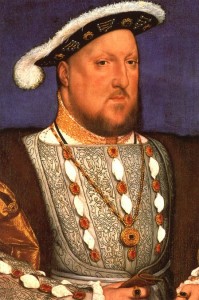 On the 19th October 1536, Henry VIII got tough on the Pilgrimage of Grace rebels. In a letter to Charles Brandon, Duke of Suffolk, Henry wrote:
On the 19th October 1536, Henry VIII got tough on the Pilgrimage of Grace rebels. In a letter to Charles Brandon, Duke of Suffolk, Henry wrote:
“You are to use all dexterity in getting the harness and weapons of the said rebels brought in to Lincoln or other sure places, and cause all the boats on the Humber or means of passage into Yorkshire to be taken up. After this, if it appear to you by due proof that the rebels have since their retires from Lincoln attempted any new rebellion, you shall, with your forces run upon them and with all extremity ‘destroy, burn, and kill man, woman, and child the terrible example of all others, and specially the town of Louth because to this rebellion took his beginning in the same.’ We have sent you this day a good sum of money, and will send more as required.”
And in a letter to the Earl of Derby:
“We lately commanded you to make ready your forces and go to the earl of Shrewsbury, our lieutenant to suppress the rebellion in the North; but having since heard of an insurrection attempted about the abbey of Salley in Lancashire, where the abbot and monks have been restored by the traitors, we now desire you immediately to repress it, to apprehend the captains and either have them immediately executed as traitors or sent up to us. We leave it, however, to your discretion to go elsewhere in case of greater emergency. You are to take the said abbot and monks forth with violence and have them hanged without delay in their monks’ apparel, and see that no town or village begin to assemble.”
You can read more about the events of the Pilgrimace of Grace rebellion in my article October 1536 – The Pilgrimage of Grace.
Also on this day in history…
- 1469 – The marriage of Ferdinand of Aragon and Isabella of Castile, the famous ‘Reyes Católicos’ and the parents of Catherine of Aragon, in the Palacio de los Vivero, Valladolid, Spain. Isabella became Queen Isabella I of Castile in 1474 and Ferdinand became King Ferdinand II of Aragon in 1479, so their marriage united the powerful kingdoms of Aragon and Castile, a vast territory which comprised most of what is modern-day Spain.
Notes and Sources
- LP xi. 780
- LP xi. 783
- Extract taken from On This Day in Tudor History by Claire Ridgway